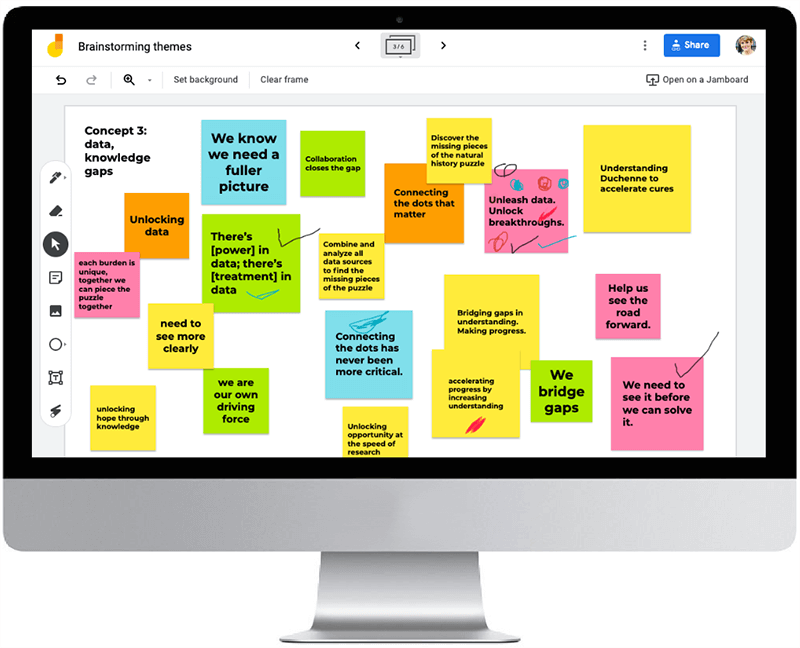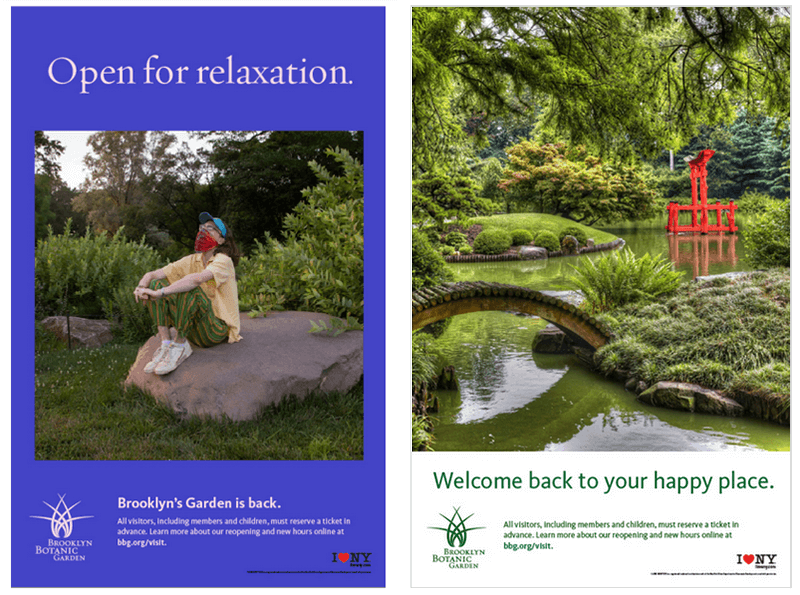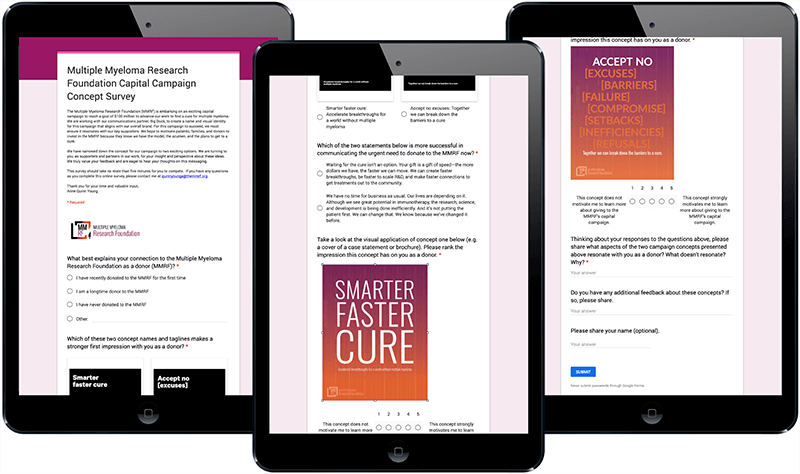You can build a strong concept for your campaign in six steps. Here’s how.
All campaigns need a strong concept—a big, unifying idea and approach that connects every aspect of the campaign experience. Campaigns that inspire action are built on an arresting, and simple, creative concept—they make the campaign identifiable and motivate folks to engage. Let’s break down the process of finding, testing, and executing a concept. We hope demystifying our workflow, and understanding how we approach finding that “big idea” for campaigns at Big Duck, will unify and strengthen your next fundraising, outreach, awareness, or advocacy campaign.
Step 1: Determine your key audiences and campaign goals.
Knowing your audience is key to creating concepts that resonate, and compel folks to take action. If you can prioritize, it will help you develop a more customized concept—the more specific you can get, the better. Are you trying to folks who share the same motivation? Or, are you trying to reach a certain geographic location? Try and narrow down if you can, to create a “primary” and “secondary” audience grouping.
Equally strategic, setting a clear campaign goal is a critical step in developing a strong concept for your campaign. It will help you shape the copy and visuals into communications that drive toward those desired actions, which might be donating, signing up for your email list, visiting your organization, attending an event, or growing awareness. While campaigns may have several goals, we recommend having one primary goal or desired outcome to drive your planning. Stuck? Ask what success looks like and keep asking why until you hit an endpoint!
Setting these two essential strategic guideposts—your audience groups and your campaign goals—will help you make decisions later about your concept’s tone, visual style, and more. Capture the goals and audiences, and any resulting creative guidelines, in a shared team document—we call this the creative brief.
Step 2: Dream big.
Brainstorm ideas for your campaign’s “big idea” or hook—go broad, and try not to curate or shut down your thoughts. Concepts at this stage can take the form of specific copy, like the tagline or slogan for the campaign, or be more general, like an underlying theme that would carry throughout the campaign. Generate ideas solo, with your internal communications department, with members of your community, with your trusted freelancers, or with the help of a creative agency. Have a brainstorming session live and in person, virtually on Zoom using remote whiteboard tools, asynchronously, or all of the above—whatever works best for your team!
If there is a primary context where this campaign will appear, like social media or an outdoor campaign, imagine your key audiences encountering the creative. How do you want them to feel? Do you want them to laugh, think, feel hopeful? What emotional experience will be most likely to compel them to take the desired action?
For a collaborative brainstorm with our friends at Parent Project Muscular Dystrophy for their 2020 Holiday campaign, we invited communications staff and our creative team to conceptualize ideas together. Later, the group added checks and marks to the ideas with the most potential, and we narrowed down the possible roads forward together, in real-time.

Once you’ve identified a handful of ideas you’re excited about, it’s time to push and refine.
Step 3: Narrow down, then map out how a few concepts come to life
Take a small selection of your ideas and creatively manifest them. Pick a key application from your campaign communications plan—a social post, a still of video, a transit ad—and use that to develop the copy and design to a place of completion. The goal is to get your concept as simple, and clear, as possible. It should be equally powerful across all the applications and contexts of your campaign, working well across digital, motion, and print.
For Brooklyn Botanic Garden’s reopening campaign, our team brought two ideas to life, and mocked them up on a faux subway ad. Getting the art and copy finalized allowed us to ask the critical question, “Which of these concepts would resonate more for Garden audiences, and inspire them to visit after a long winter of feeling cooped-up, anxious, and scared from COVID?”
Concept 1, “Open for [relaxation, joy, fun]” showed Brooklynites safely enjoying the Garden.
Concept 2, “Your Happy Place,” by contrast, showed the Garden with no one else in the frame and allowed each visitor to envision themselves there. Which image would better reassure folks? And which line of copy would more likely inspire a visit?

Ultimately, the concept on the left landed better and allowed the Garden to show a variety of different folks engaging with nature and having unique—and safe—experiences at the Garden.
Step 4: Get feedback and pressure test
If you’ve got two creative tactics, it’s always helpful to test them. Do you have a big enough email list or site visitors to do A/B testing via email or landing pages with final choices like image or tagline options? Can you poll your community members, and your priority audience, to get a read on which direction is working, or if any art or copy needs to be tweaked? Testing is a great way to not only find a concept that works and ensure that what you’re making is mission-aligned and community-centric.
For a capital campaign for The Multiple Myeloma Research Foundation, an organization dedicated to an incurable blood cancer, we sent concepts to a group of major donors—visuals, tagline, and some messaging—and asked for their reactions. The feedback helped us creatively shape the concept to be more successful with our primary audience.

Step 5: Go live!
Once you’ve got a green light on your final art and copy, do what needs to be done to bring it to life. Commission photoshoots, purchase placeholder art and finalize any illustrations. Or maybe it’s as simple as resizing and producing art for a variety of media in your plan. Sometimes extending the concept into long and short-form applications—playing out the ideas in video, or an Instagram story for example—provides new opportunities to layer on meaning or additional creative variation.
Step 6: Track your progress.
How close did you get to reaching your goal? Did you meet any of the objectives you hoped to accomplish? How did your campaign perform out in the real world? Were your open, click-through, and response rates strong? Did folks convert to the desired online or in-person actions embedded throughout the campaign? Data on the campaign is an invaluable asset in developing future campaigns, so make sure you have the tools you need in place to track your campaign’s performance. Write up and share some key insights and takeaways with your team so that you can learn from how your concept worked.
These steps map out our usual method of finding and creating that “big idea”. The truth is that though this is our tried and true approach, there’s no one right way to develop a creative concept for your campaign. Whatever path you take, any successful nonprofit campaign must center on a clear creative concept cohesively uniting every audience touchpoint, making connections with those you’re aiming to reach. If you are curious, you can see more examples of our campaign work here.





